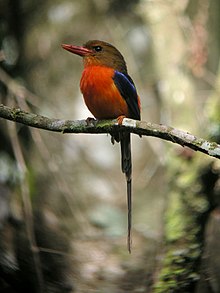Brown-headed paradise kingfisher
| Brown-headed paradise kingfisher | |
|---|---|
 |
|
| Scientific classification | |
| Kingdom: | Animalia |
| Phylum: | Chordata |
| Class: | Aves |
| Order: | Coraciiformes |
| Family: | Alcedinidae |
| Subfamily: | Halcyoninae |
| Genus: | Tanysiptera |
| Species: | T. danae |
| Binomial name | |
|
Tanysiptera danae Sharpe, 1880 |
|
The brown-headed paradise kingfisher (Tanysiptera danae), also known as the russet paradise kingfisher, is a species of bird in the family Alcedinidae. It is endemic to the lowland forest in south east Papua New Guinea. Its natural habitats are temperate forests and subtropical or tropical moist lowland forests. Like all paradise kingfishers this bird has colourful plumage with a red bill and distinctive long tail streamers.
The first formal description of the brown-headed paradise kingfisher was by the English ornithologist Richard Bowdler Sharpe in 1880 from specimens collected near Milne Bay in southeastern New Guinea. He coined the current binomial name Tanysiptera danae. The genus Tanysiptera had been introduced by the Irish zoologist Nicholas Aylward Vigors in 1825. The name Tanysiptera is from classical Greek tanusipteros meaning "long-feathered". The specific epithet danae is from Greek mythology; Danaë was the daughter of Acrisius, King of Argos. The species is monotypic.
The brown-headed kingfisher is 23 cm (9.1 in) in length excluding the streamers which are up to 9 cm (3.5 in). The sexes are alike. The head, mantle and scapulars are a warm rufous-brown. The rump, breast and belly are pink-red. The flight feathers are black and the greater coverts are bright blue. The tail is dark purplish blue, the bill is red and the legs and feet are pink or orange.
...
Wikipedia

